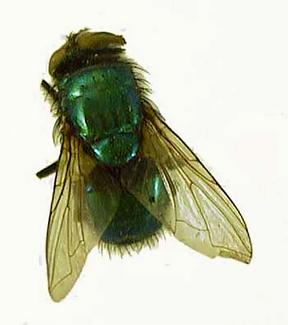
 |


Habitat
Adults: terrestrial
Immatures: terrestrial
Feeding Habits
Adults: nectar and pollen feeding
Immatures: saprophagous
Size: 4 to 16 mm
Flight : strong flier
North American
Species: 70
|
Diptera Calliphoridae
Blow flies
Front Wings: membranous
Hind Wings: reduced to halteres
Mouthparts: sponging
Antenna Length: shorter than body
Antenna Shape: straight
Front Legs: unmodified
Hind Legs: unmodified
Special Characteristics:
Calliphoridae are robust medium to large sized flies, often with metallic blue or green on the abdomen and thorax. One common species, the cluster fly, has a dull, non-metallic body with silky yellow hairs on the thorax. They have a well developed calypter at the base of each wing.
|
|
Species:
Phaenicia sericata (Meigen)
Common Name:
Green bottle fly
Feeding Habits: The larvae feed on decomposing animal matter.
Distribution:
Southern Canada
Comments:
Because larvae of this species feed only on dead and decaying tissues and not on healthy tissues, they have been used successfully to treat osteomyelitis and other medical conditions in humans. This is known as maggot therapy.
|

|